Bringing analog musicality to the portable digital world.
- Very well constructed
- Clear OLED screen
- The first R-2R dongle and most affordable R-2R DAC
- Great sound
- Reasonable source battery draw
- Trades ultimate resolution for euphonic sound
- Premium price for a dongle
- Volume control sometimes temporarily mutes sound
- No included Lightning to USB-c cable
- Somewhat prone to EMI interference
The Cayin RU6 is getting a little long in the tooth, given the unending torrent of new dongle DAC/amps. Is it just me, or does it seem like every company has created near-countless models over the last few years?
For the most part, the dongles are all virtually indistinguishable, sharing the same basic features, shape, size, and, in many cases, highly similar sonic performance.
But even so long after the original release of the RU6 (late 2021), it remains a singular product worthy of attention.
The RU6 is a product of firsts.
It is the first dongle DAC/amp created by legendary audio company Cayin and the first dongle to use a discrete 24-bit R-2R (resistor ladder) chipset. It is also the most affordable R-2R DAC available.
Except for the Hiby FC6 and Cayin RU7, the RU6 has virtually no direct R-2R competitors. This may likely be explained by the simple fact that standard delta-sigma (D-S) chipset-based DACs are easier and cheaper to implement.
Or it may be because R-2R DACs measure objectively worse, and perusing tech specs is an easy way for consumers to compare these devices and for companies to advertise.
Enthusiasts will throw around words like ‘analog-sounding,’ ‘tube-like,’ or ‘musical’ to describe R-2R DACs. Others will turn their noses up at any device that possibly adds distortion to the audio chain.
Does a new take on an old-fashioned approach to digital audio conversion really offer something better for the listener? There’s only one way to find out.
Unboxing and First Impression
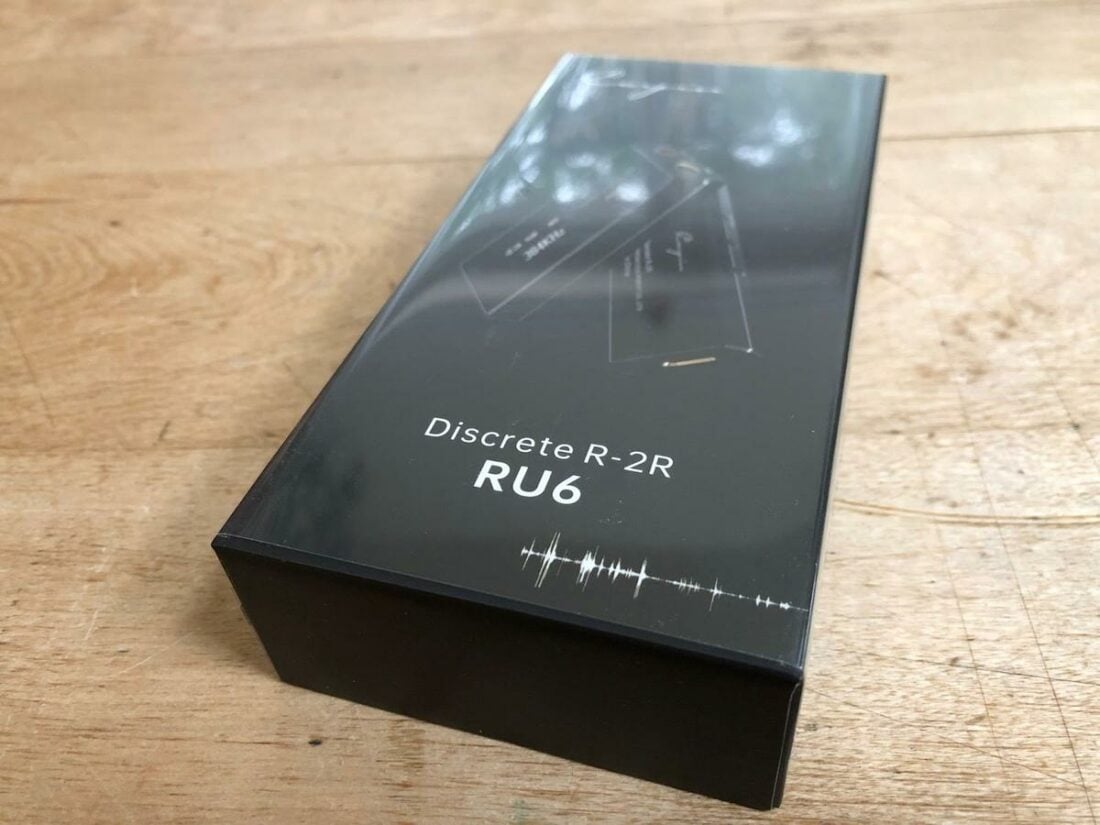
Design and Build
For such an unusual device, the RU6 adopts the standard dongle shape and size with a single USB-c port on one end and two (3.5mm SE, 4.4mm balanced) headphone jacks on the other. At first glance, it’s easy to dismiss the unusual technology contained within.
Upon close inspection, the 28g aluminum body does elevate itself above the standard fare.
All the ports are gold-plated, and the front surface is glass, housing a 1-inch OLED screen for menu navigation. The top has 3 small buttons (volume +/-, mode) that have a satisfying tactile click. Both top and bottom are slightly angled outwards, which provides a pleasing feeling in hand.
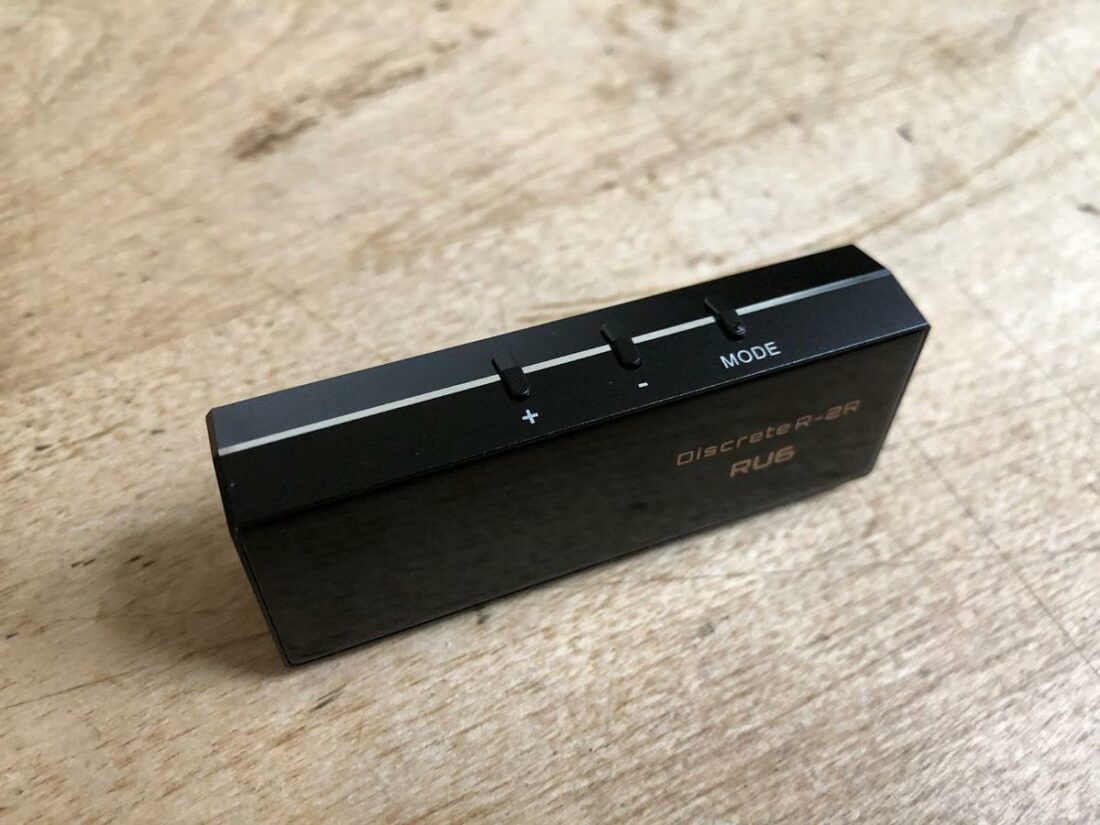
Controls
Simply plug the included USB-c cable (and, if required, USB-A adapter) into a DAP or Apple/Android/Windows device, and the screen will illuminate with the Cayin logo. The screen will change to show the volume, gain, sampling rate, and sampling (NOS/OS) mode. After a few seconds, the display will shut off to maintain the battery life of the source device.
Short press the mode button to turn the screen on or off. Long press the mode button to enter the simple menu settings.
- Gain: High/Low
- Sampling: NOS/OS
- Backlight: 10s-60s, On
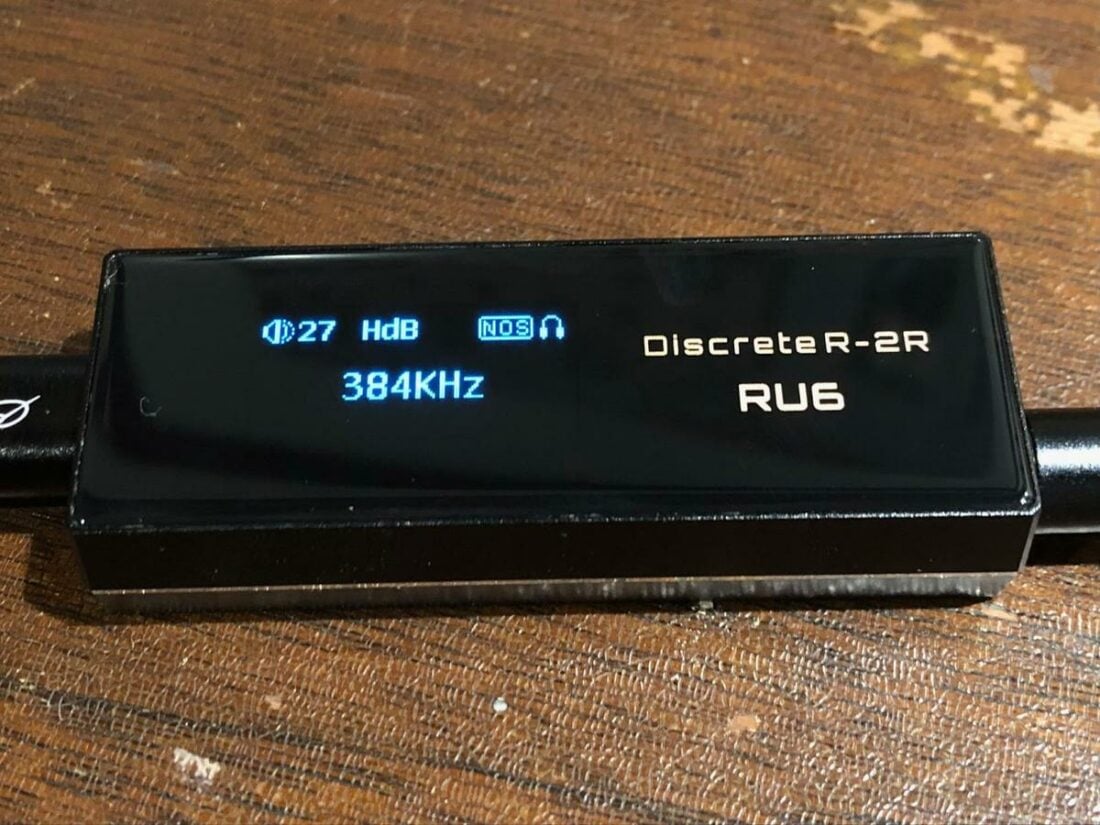
Oversampling OS and Non-Oversampling NOS modes
While you are likely familiar with high and low gain options, R-2R DACs often offer the ability to switch between oversampling (OS) and non-oversampling (NOS) modes. In a nutshell, the RU6’s OS mode uses digital filters to upsample all audio data to 384kHz, while the NOS mode maintains the original sampling rate.
OS benefits are touted as reduced noise and improved resolution, resulting in cleaner presentation and enhanced details. NOS mode improves phase distortion and reduces artifacts and jitter, resulting in smoother, more euphonic playback. Or so they claim.
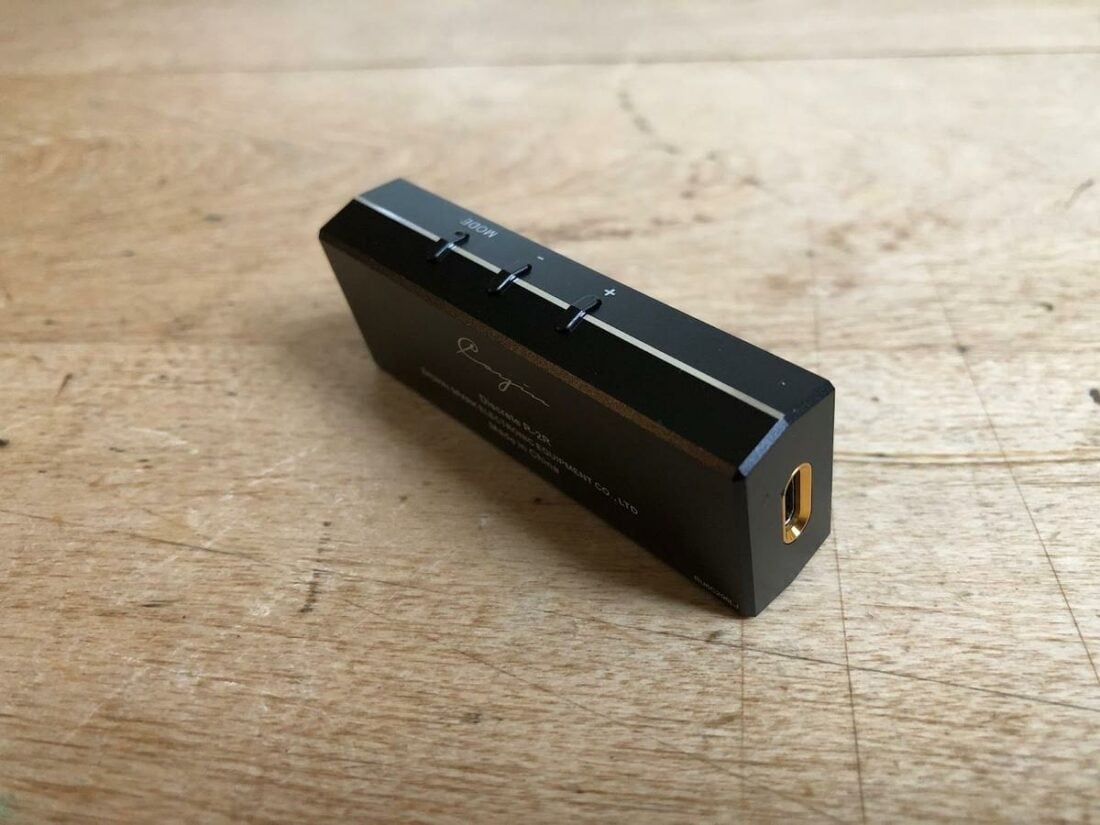
Battery
Using my basic FNIRSi FNB48 USB power meter, I measured between 0.11-0.35A power draw depending on the headphone load. This translates to a perfectly reasonable power consumption, on par with other delta-sigma dongles I have measured.
Not to fear, the RU6 isn’t a power hog.
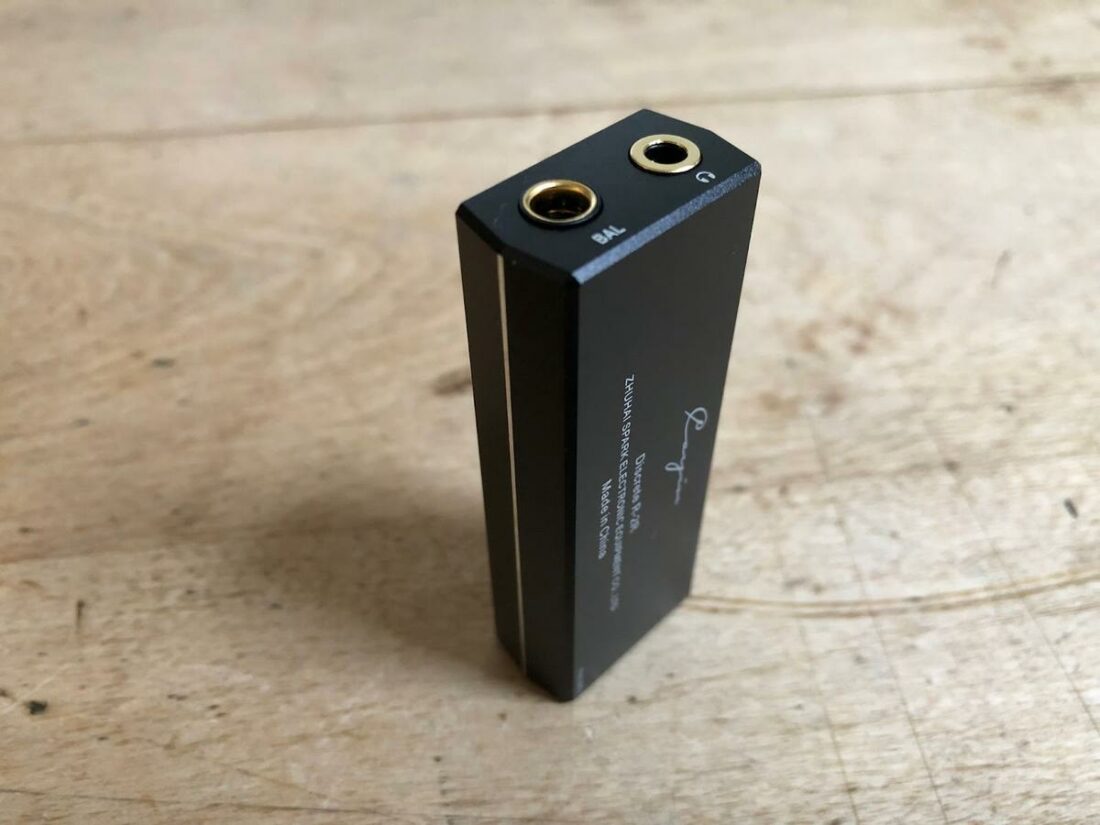
Under the Hood
For those concerned that an R-2R type DAC can’t handle high-resolution files, let me set your mind at ease. The RU6 can decode up to 24-bit, 384kHz PCM and 256DSD. While these aren’t the highest possible values, it is more than enough to handle most hi-res files you will likely encounter.
An R-2R DAC must have twice the number of resistors per channel as the number of ‘bits’ being decoded. So, 24-bit decoding requires (24 x 2 = 48 x 2 channel stereo =) 96 discrete resistors. The RU6 uses 0.1% ultra-precision TCR25 thin film resistors in this case.
The analog and digital circuits are split between two boards to minimize noise.
Analog resistor volume control
I greatly appreciate the physical volume control buttons on the RU6. Inside the device is a clever combination of additional resistors and relays that translate to 99 steps of analog volume manipulation. Plenty to precisely dial in your preferred loudness.
While this is a highly accurate method of volume control, the use of relays means that the sound will be occasionally muted momentarily when changing the volume. It’s a little off-putting when first using the RU6, but I soon got used to it as I tend to be a ‘set it and forget it’ kind of listener.
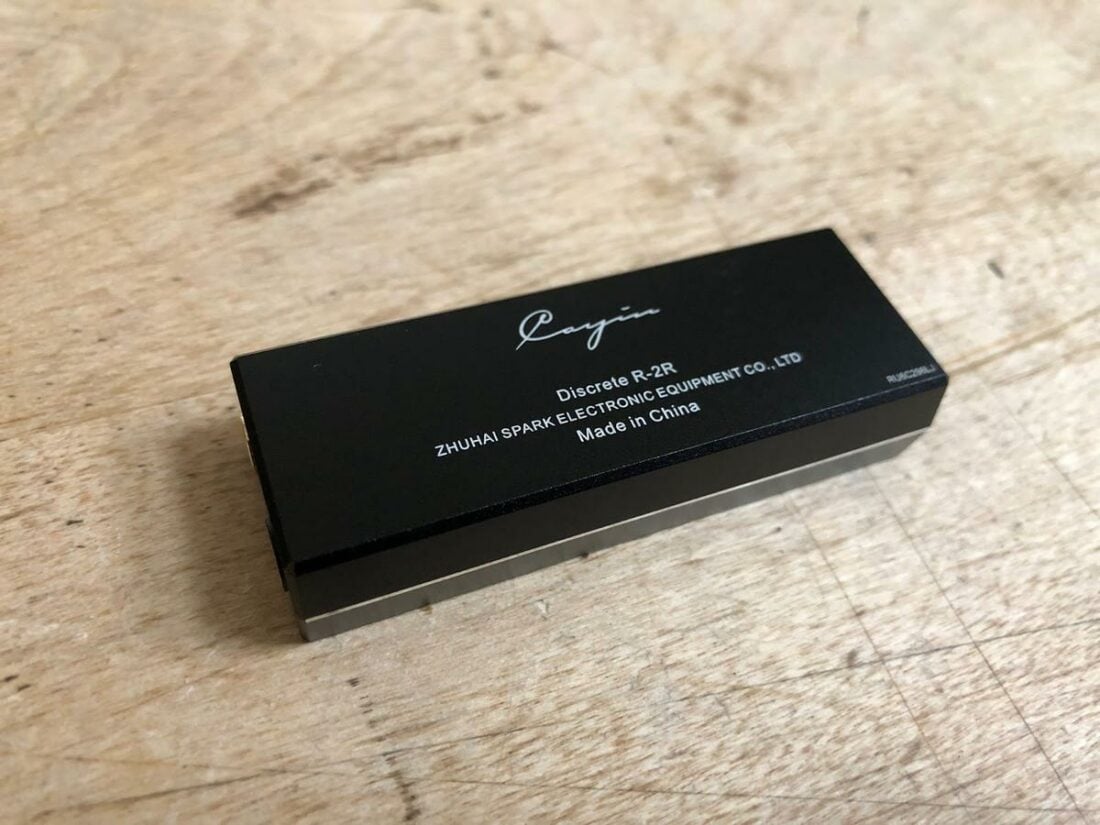
How Does the RU6 Sound?
With less than 1 Ohm of output impedance, the RU6 plays nicely with basically any IEMs or headphones.
Although the shape and size of the dongle are rather ordinary, Cayin set out to do something different with the RU6. Braving the additional cost and complexity of an R-2R design is only worth the trouble if it brings something special to the table.
So, was it worth it? Does the RU6 sound different than Delta-Sigma DACs? Does it sound better?
Well, yes. Sorta.
The differences aren’t quite as dramatic as you (or I) might expect.
The RU6 is a reasonably clean, uncolored, and natural-sounding dongle. It maintains very good transparency and resolution. Detail retrieval is decent, and the impression of space and soundstage seems at least on par with good D-S dongle DACs.
What it does well is to avoid harshness.
Although, at times, when I use the NOS setting, I think things may sound a touch hazy – a subtle distortion on sharper notes. It’s not bothersome and is elusive enough that it may be imagination on my part. Like I said, it’s subtle.
Just as nebulous are the audible differences between the OS and NOS modes. With my critical listening ears screwed in place and using very good IEMs, the audio positioning cues may be a touch more defined using OS mode, resulting in a crisper and more transparent overall sound.
On the other hand, isn’t NOS mode the point of an R-2R DAC?
Most of my listening used the NOS mode. This way, it’s doing the job in a more old-fashioned way – none of this newfangled upsampling and the like. Yes, I may be delusional, but isn’t this – at least partially – what R-2R DAC users are after?
To my ears, the NOS mode sounds softer and fuller. It’s a touch more vocal-centric and warmer in the midrange. Tube amps and vintage stereos appeal to me, so I will sacrifice some of the highest fidelity for a more real-feeling and visceral musical presentation.
The NOS mode scratches the itch for a ‘big’ sound.
Again, let me stress that the differences really are pretty slight, and you won’t immediately feel the music has been dipped in buttery syrup with NOS mode enabled. Nor does OS mode scream “digital” to me.
I expect to many listeners, at least partially, that the pleasure of using this device will come from knowing there is an R-2R DAC inside the RU6. But if no one told you, you might never suspect it is vastly different inside than any other competent dongle – regardless of the tech used.
Unfortunately, I occasionally run into unwanted noise from my phone. I live in a virtual dead zone for cellular coverage, and when my phone goes into repeated searching for signal mode, I can sometimes hear buzzing and interference. YMMV (and likely will) based on your phone and coverage. Disabling cellular on my phone fixes the issue.
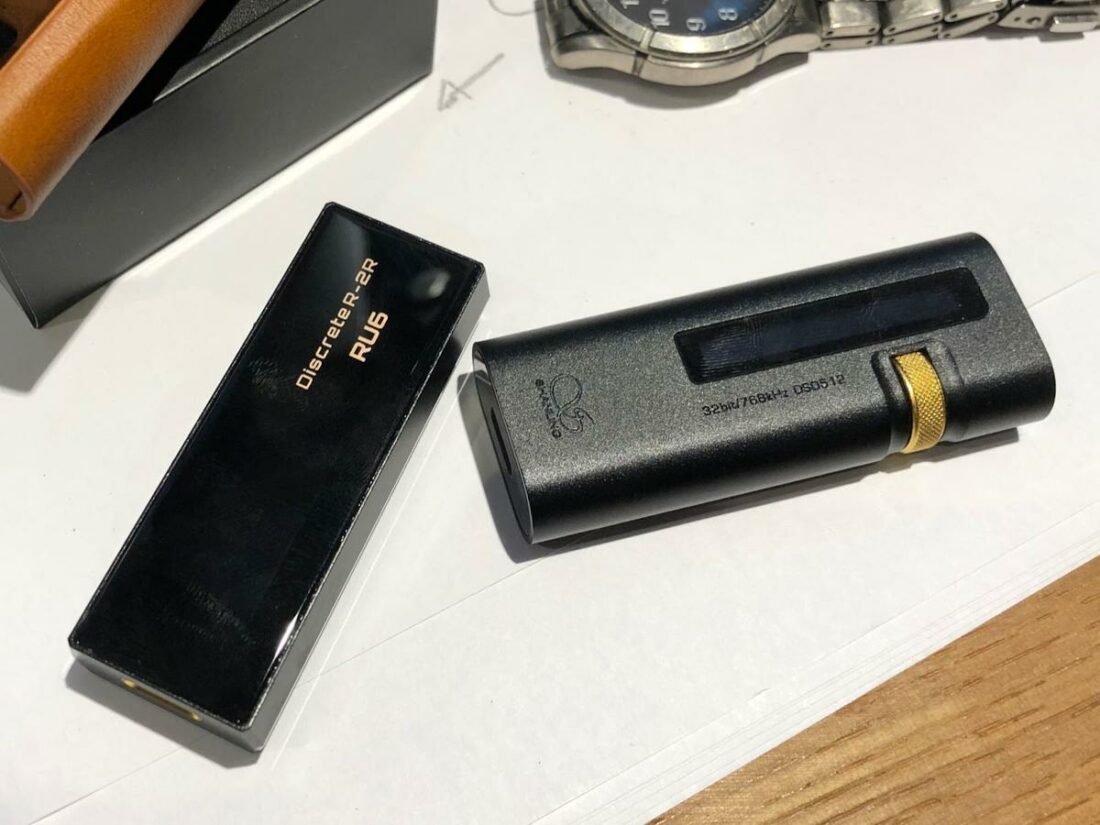
Comparisons
You can choose one of the best D-S DAC dongles, the Shanling UA5, for approximately the same cost (at a bit over USD$200). The UA5 boasts an incredibly rich feature set and excellent sound.
Both devices use a small OLED screen for selecting options, are of similar size and construction, and have balanced and SE headphone outputs with nearly identical output power. Neither comes with USB-c to Lightning cables. I prefer the sizeable rotating volume control/button on the UA5 to the RU6’s tiny buttons.
The UA5 uses dual ESS ES9038Q2M chips, and supports 32-bit/768kHz/DSD512, as compared to the RU6 24-bit/384kHz/DSD256. This is of dubious importance in overall sound quality.
So, really, it comes down to which one sounds better. I expect that, in general, most folks will prefer the UA5.
Hear me out. The UA5 sounds clean and precise – no veil, distortion, or unwanted artifacts exist. However, in direct comparison with the RU6, you may find the UA5 a touch lean and clinical. But it offers a consistent performance that sounds good with anything you plug into it.
The RU6 is meatier, deeper, and more grounded sounding than the UA5. This can work exceptionally well with some brighter IEMs and headphones and less well with others. It’s a somewhat more colored sound that can make magic or fall a little flatter than the tried-and-true sound of the UA5.
Where to Buy
Who Should Buy This?
The RU6 is a perfect companion piece if you own an excellent D-S dongle. Rather than buying an almost identical-sounding dongle with a slightly different chipset, it’s well worth checking out what R-2R offers.
I expect the Cayin RU6 is most likely to appeal to those audiophiles interested in gear that imparts ‘character’ to the music they listen to; tube amp junkies, vinyl collectors, vintage stereo geeks, etc. Dare I say, lovers of all things analog?
The RU6 really isn’t for those who chase the highest specs, cleanest output, and most precise measurements or those who believe that accuracy is paramount. If you prioritize eradicating all distortion in the sonic chain, you should consider a dongle like the Shanling UA5.
Some gear is designed around the principle that musical enjoyment can’t be found in the tech specs and measurements – an ethos that accepts that (perhaps) the highest fidelity can be compromised for a more euphonic listener experience.

Final Thoughts
I had high hopes for my first R-2R experience and the RU6. Bringing R-2R tech to the masses with a tiny, affordable dongle is no small accomplishment. So many things could have gone wrong, but the RU6 is a success.
Perhaps my expectations that the RU6 should sound ‘more different’ than other terrific D-S DACs were misguided. Realistically, the audible difference can’t be that significant and still have the music sound right and proper. Rather than expecting kale when I ordered a steak, I should have known that the RU6 would offer different seasonings to an already fantastic meal.
Admittedly, I’m the target audience for a product like the RU6. It’s an easy buy for audiophile collectors looking for something other than the ordinary. It promises a more analog experience hidden within a standard-looking device.
If part of your listening pleasure can be found in knowing how the music gets to your ears, the RU6 delivers that on the go. Just be prepared for your non-audiophile friends to glaze over and look at you as if you are speaking Martian when you try to explain why it’s so special.
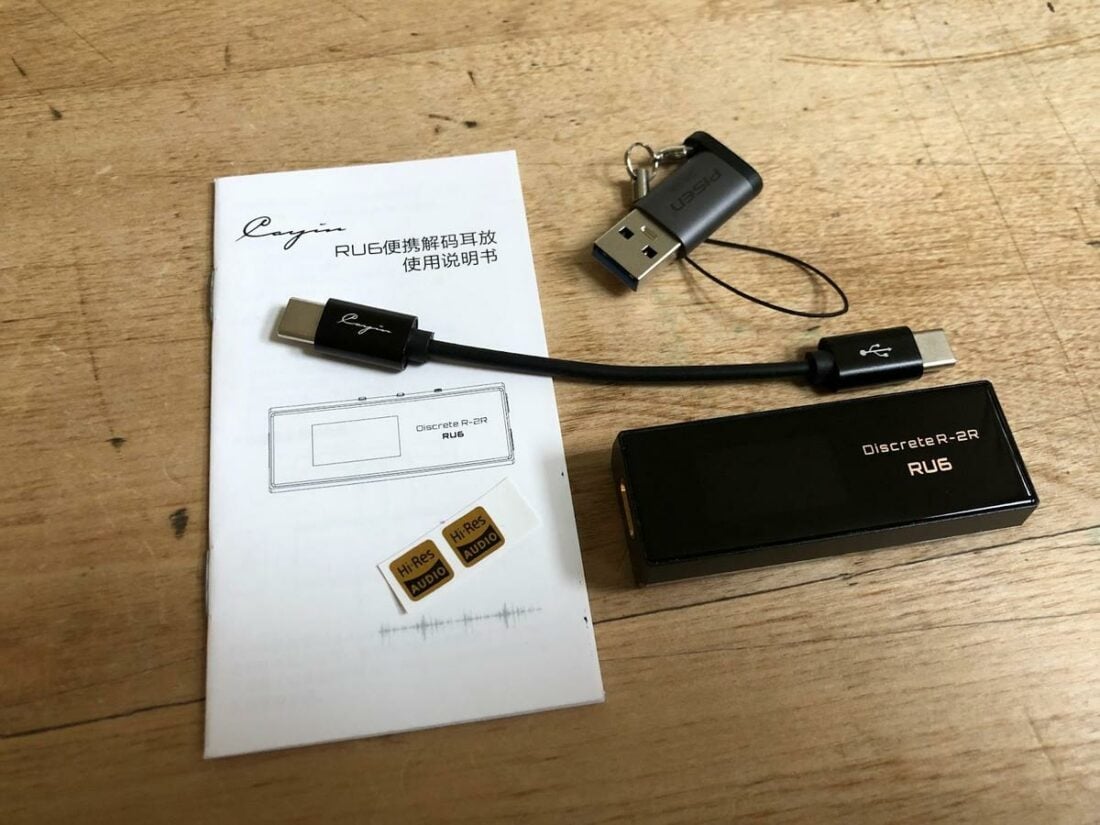
What’s in the Box?
- Cayin RU6
- USB-c to USB-c OTG cable
- USB-c to USB-a adapter
- User manual
- Hi-Res stickers
Technical Specifications
- Form: Dongle DAC/amp
- DAC: 384kHz/DSD256
- Dynamic Range: SE: 109dB (20Hz-20kHz, A-Weighted), Balanced: 110dB (20Hz-20kHz, A-Weighted)
- Output Power: SE: 138mW@32ohms, Balanced: 213mW@32ohms
- Impedance (Ohm): 0.5 Ohms
- Weight (g): 28g
- Size: 65×25.4×13.7mm
